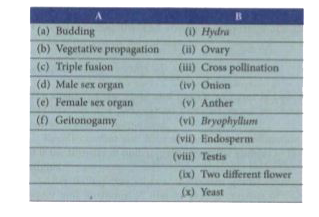Which of the following property of a proton can change while it moves freely in a magnetic field?
(There may be more than one correct answer).
(i)
(ii)
(iii)
(iv)
A
mass
B
speed
C
velocity
D
momentum
Text Solution
Whenever a charged particle (in this case a proton) moves in a magnetic field, its velocity and as a result of this its momentum change. Thus, (c) and (d) are the properties which change when a proton moves freely in a magnetic field.
|
Topper's Solved these Questions
- MAGNETIC EFFECTS OF ELECTRIC CURRENTBOOK - VK GLOBAL PUBLICATIONCHAPTER - MAGNETIC EFFECTS OF ELECTRIC CURRENTEXERCISE - NCERT Exercises
36 Videos
- MAGNETIC EFFECTS OF ELECTRIC CURRENTBOOK - VK GLOBAL PUBLICATIONCHAPTER - MAGNETIC EFFECTS OF ELECTRIC CURRENTEXERCISE - VERY SHORT ANSWER QUESTIONS
50 Videos
- LIGHT-REFLECTION AND REFRACTIONBOOK - VK GLOBAL PUBLICATIONCHAPTER - LIGHT-REFLECTION AND REFRACTIONEXERCISE - PROFICIENCY EXERCISE (Long Answer Questions)
5 Videos
- MANAGEMENT OF NATURAL RESOURCESBOOK - VK GLOBAL PUBLICATIONCHAPTER - MANAGEMENT OF NATURAL RESOURCESEXERCISE - HOTS (Higher Order Thinking Skills)
7 Videos
Similar Questions
Knowledge Check
Which of the following properties of a proton can change while it moves freely in a mangetic field? (There may be more than one correct answer).
A(a) massB(b) speedC(c) velocityD(d) momentumWhich of the following change (s) in the presence of catalyst ? (More than one correct answer)
AVelocity coefficient of the reactionBΔGɵ of the reactionCEnergy of activationDΔH of the reactionWhich one of the following is not true about properties of magnetic field lines?
AThey come out from North pole and go into South poleBThey form closed loopsCThey intersect when two magnets are keptDThey are closely spaced in the region of strong magnetic field
Match the following with one or more than one correct answer.


View SolutionWhich of the following change (s) in the presence of catalyst ? (More than one correct answer)
View SolutionWhich of the following can have the value of more than one and less than zero: (i) APC, (ii) APS, (iii) MPC, and (iv) MPS ?
View SolutionWhich one of the following is not true about properties of magnetic field lines?
View SolutionWhich of the following statement (s) is/are correct (may have more than one option correct):
View Solution

